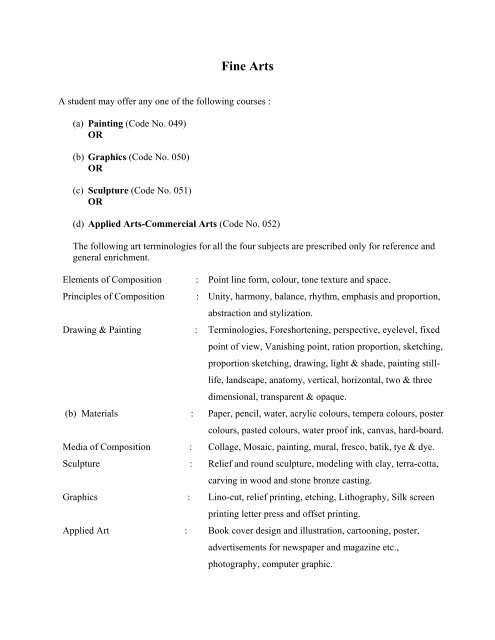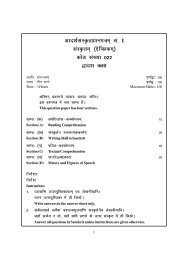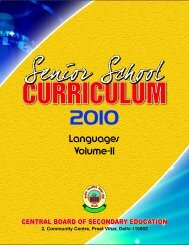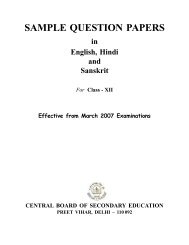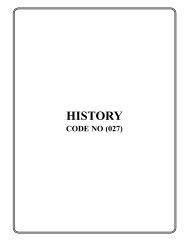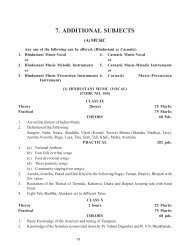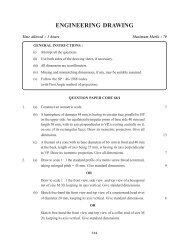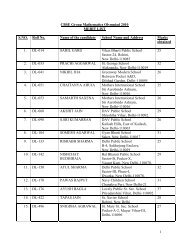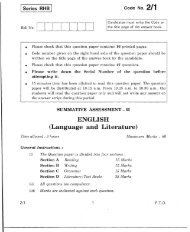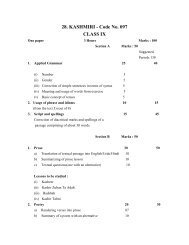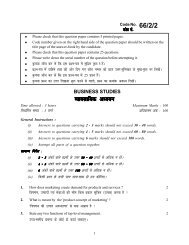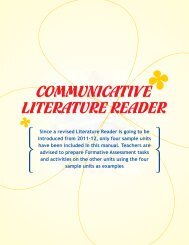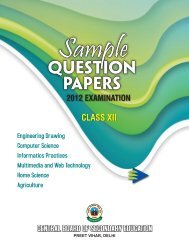Fine Arts - Central Board of Secondary Education
Fine Arts - Central Board of Secondary Education
Fine Arts - Central Board of Secondary Education
Create successful ePaper yourself
Turn your PDF publications into a flip-book with our unique Google optimized e-Paper software.
<strong>Fine</strong> <strong>Arts</strong><br />
A student may <strong>of</strong>fer any one <strong>of</strong> the following courses :<br />
(a) Painting (Code No. 049)<br />
OR<br />
(b) Graphics (Code No. 050)<br />
OR<br />
(c) Sculpture (Code No. 051)<br />
OR<br />
(d) Applied <strong>Arts</strong>-Commercial <strong>Arts</strong> (Code No. 052)<br />
The following art terminologies for all the four subjects are prescribed only for reference and<br />
general enrichment.<br />
Elements <strong>of</strong> Composition : Point line form, colour, tone texture and space.<br />
Principles <strong>of</strong> Composition : Unity, harmony, balance, rhythm, emphasis and proportion,<br />
abstraction and stylization.<br />
Drawing & Painting : Terminologies, Foreshortening, perspective, eyelevel, fixed<br />
point <strong>of</strong> view, Vanishing point, ration proportion, sketching,<br />
proportion sketching, drawing, light & shade, painting stilllife,<br />
landscape, anatomy, vertical, horizontal, two & three<br />
dimensional, transparent & opaque.<br />
(b) Materials : Paper, pencil, water, acrylic colours, tempera colours, poster<br />
colours, pasted colours, water pro<strong>of</strong> ink, canvas, hard-board.<br />
Media <strong>of</strong> Composition : Collage, Mosaic, painting, mural, fresco, batik, tye & dye.<br />
Sculpture : Relief and round sculpture, modeling with clay, terra-cotta,<br />
carving in wood and stone bronze casting.<br />
Graphics : Lino-cut, relief printing, etching, Lithography, Silk screen<br />
printing letter press and <strong>of</strong>fset printing.<br />
Applied Art : Book cover design and illustration, cartooning, poster,<br />
advertisements for newspaper and magazine etc.,<br />
photography, computer graphic.
Painting (Code No. 049)<br />
Introduction<br />
The course in Painting at Senior <strong>Secondary</strong> stage as an elective subject is aimed to develop<br />
aesthetic sense <strong>of</strong> the students through the understanding <strong>of</strong> various important well known<br />
aspects and modes <strong>of</strong> visual art expression in India’s rich cultural heritage from the period Indus<br />
valley to the present time. It also encompasses practical exercises in drawing and painting to<br />
develop their mental faculties <strong>of</strong> observation, imagination, creation and physical skills required<br />
for its expressions.<br />
Objectives<br />
(3) Theory (History <strong>of</strong> Indian Art)<br />
The objective <strong>of</strong> including the history <strong>of</strong> Indian Art for the students is to familiarize them with<br />
the various styles and modes <strong>of</strong> art expressions from different parts <strong>of</strong> India. This would enrich<br />
their vision and enable them to appreciate and develop an aesthetic sensibility to enjoy the<br />
beauty <strong>of</strong> nature and life. The students will also have an opportunity to observe and study the<br />
evolution <strong>of</strong> its mutations and synthesis with other style and the rise <strong>of</strong> an altogether new style.<br />
The students should be made aware <strong>of</strong> art as a human experience. The teachers should be able to<br />
expose them to the wide range <strong>of</strong> artistic expressions, the media and the tools used.<br />
The history <strong>of</strong> Indian Art is a long one. Hence the students would be acquainted with brief<br />
glimpses <strong>of</strong> the development <strong>of</strong> Indian Visual Art as are required for concept formation.<br />
Examples included in the course <strong>of</strong> study are selected because <strong>of</strong> their aesthetic qualities and are<br />
intended purely as guidelines.<br />
(3) Practicals<br />
The purpose <strong>of</strong> introducing practical exercises in Painting is to help and enable the students :<br />
- To develop skill <strong>of</strong> using drawing and painting material (surface, tools and equipments<br />
etc.)<br />
- To sharpen their observation skills through study <strong>of</strong> common objects and various<br />
geometrical and non-geometrical forms found in life and nature.<br />
- To develop their skills to draw and paint these observations ;<br />
- To develop an understanding <strong>of</strong> Painting-Composition (The use <strong>of</strong> the elements and the<br />
principles <strong>of</strong> painting-composition)
- To create the forms and the colour schemes in imagination with an ability to express<br />
them effectively in drawing and painting;<br />
- To express the different feelings and moods <strong>of</strong> life and nature in lines, forms and colours.<br />
CLASS XI (THEORY)<br />
One Paper Time : 1 Hour 30 Marks<br />
Unitwise Weightage<br />
Units<br />
Marks<br />
History <strong>of</strong> Indian Art<br />
1. Art <strong>of</strong> Indus Valley 5<br />
2. Buddhist, Jain & Hindu Art 10<br />
3. Temple Sculpture, Bronzes and Artistic aspects <strong>of</strong> Indo-Islamic Architecture 15<br />
Unit 1 : Art <strong>of</strong> Indus Valley<br />
12 Pds.<br />
(Harappan and Mohenjo-daro)<br />
(2500 B.C. to 1500 B.C.)<br />
(1) Introduction<br />
(i)<br />
(ii)<br />
Period and Location<br />
Extension : In about 1500 miles<br />
(2) Study <strong>of</strong> following<br />
Sculptures and Terracottas :<br />
(a) Harappa & Mohenjo-daro (Now in Pakistan)<br />
(b) Ropar, Lothal, Rangpur, Alamgirpur, Kali Bangan, Banawali and<br />
Dhaula Veera (in India)<br />
(i)<br />
Dancing girl (Mohenjo-daro)<br />
Bronze, 10.5 x 5 x 2.5 cm.<br />
Circa 2500 B.C.<br />
(Collection : National Museum, New Delhi).
(ii)<br />
(iii)<br />
Male Torso (Harappa)<br />
Stone, 9.2 x 5.8 x 3 cms<br />
Circa 2500 B.C.<br />
(Collection : National Museum, New Delhi).<br />
Mother Goddess (Mohenjo-daro) terracotta, 22 x 8 x 5 cm.<br />
Circa 2500 B.C.<br />
(Collection : National Museum, New Delhi)<br />
(3) Study <strong>of</strong> following<br />
Seal :<br />
(i) Bull (Mohenjo-daro)<br />
Stone, 2.5 x 2.5 x 1.4 cm.<br />
Circa 2500 B.C.<br />
(Collection : National Museum, New Delhi).<br />
(4) Study <strong>of</strong> following<br />
Decoration on earthern wares :<br />
(i)<br />
Painted earthern-ware (Jar) Mohenjo-daro)<br />
Collection : National Museum, New Delhi).<br />
Unit 2 : Buddhist, Jain and Hindu Art 24 Pds.<br />
(3 rd century B.C. to 8 th century A.D.)<br />
(1) General Introduction to Art, during Mauryan, Shunga, Kushana & Gupta period :<br />
(2) Study <strong>of</strong> following<br />
Sculptures :<br />
(i)<br />
(ii)<br />
Lion Capital from Sarnath (Mauryan period)<br />
Polished sandstone,<br />
Circa 3 rd Century B.C.<br />
(Collection : Sarnath Museum, U.P.)<br />
Chauri Bearer from Didar Ganj (Mauryan period)<br />
Polished sandstone<br />
Circa 3 rd Century B.C.<br />
(Collection : Patna Museum, Bihar)
(iii)<br />
(iv)<br />
(v)<br />
(vi)<br />
Bodhisattva head from Taxila (Gandhara)<br />
Stone, 27.5 x 20 x 15 cm.<br />
Circa 2 nd Century A.D.<br />
(Collection : National Museum, New Delhi)<br />
Seated Buddha from Katra Tila<br />
Mathura-Kushan Period<br />
(Collection : Mathura Museum)<br />
Seated Buddha from Sarnath (Gupta)<br />
Stone<br />
Circa 5 th century A.D.<br />
(Collection : Sarnath Museum, U.P.)<br />
Jain Tirathankara<br />
Stone,<br />
Circa 5 th Century A.D.<br />
(Collection : State Museum, Lucknow, U.P.)<br />
(3) Introduction to Ajanta<br />
Location, period, No. <strong>of</strong> caves, Chaitya and Vihara, Paintings and Sculptures subject<br />
matters and technique etc.<br />
(4) Study <strong>of</strong> Following<br />
Painting & Sculpture :<br />
i) Padmapani Bodhisattva (Ajanta Cave No. 1)<br />
Mural Painting<br />
Circa 5 th Century A.D.<br />
ii) Mara Vijay (Ajanta Cave No. 26)<br />
Sculpture in stone.<br />
Circa 5 th Century A.D.<br />
Unit 3 : Temple Sculpture, Bronzes and Indo-Islamic Architecture 36 Pds.<br />
Artistic aspects <strong>of</strong> Indian Temples<br />
(6 th Century A.D. to 13 th Century A.D.)<br />
(1) Introduction to Temple Sculpture<br />
(6 th Century A.D. to 13 th Century A.D.)
(2) Study <strong>of</strong> following Temple-Sculptures :<br />
(i)<br />
(ii)<br />
(iii)<br />
(iv)<br />
(v)<br />
(vi)<br />
Descent <strong>of</strong> Ganga (Pallava Mahabalipuram Tamilnadu period) Stone Circa 7 th<br />
Century A.D.)<br />
Ravana shaking Mount Kailash (Rashtrakuta Ellora, Maharashtra) Stone Circa<br />
Circa 8 th Century A.D.<br />
Trimurti (Elephanta, Maharashtra)<br />
Stone Circa 9 th Century A.D.<br />
Lakshmi Narayana (Kandariya Mahadev Temple) (Chandela, Khajuraho,<br />
M.P.) Circa 10 th Century A.D.<br />
Cymbal Player Sun Temple (Ganga Dynasty, Konark, Orissa)<br />
Stone, Circa 13 th Century A.D.<br />
Mother & Child (Vimla-Shah Temple, Solanki Dynasty, Dilwara, Mount Abu,<br />
Rajasthan) White Marble.<br />
Circa 13 th Century A.D.<br />
(3) Bronzes 12 Pds.<br />
(i)<br />
(ii)<br />
Introduction to Indian Bronzes<br />
Method <strong>of</strong> casting (solid and hollow)<br />
(4) Study <strong>of</strong> following South Indian Bronzes :<br />
(i)<br />
(ii)<br />
Nataraj (Thanjavur Distt., Tamilnadu)<br />
Chola period (12 th Century A.D.)<br />
(Collection : National Museum, New Delhi)<br />
Devi (Uma)<br />
Chola Period (11 th Century A.D.)<br />
(Collection : National Museum, New Delhi)<br />
(5) Artistic Aspects <strong>of</strong> the Indo-Islamic Architecture 12 Pds.<br />
(i)<br />
Introduction<br />
(6) Study <strong>of</strong> following architectures :<br />
(i)<br />
(ii)<br />
(iii)<br />
Qutab Minar, Delhi<br />
Taj Mahal, Agra<br />
Go Gumbaj <strong>of</strong> Bijapur
CLASS XI (Practical)<br />
One Paper Time : 6 Hours 70 Marks<br />
Unitwise Weightage<br />
Units<br />
Marks<br />
1. Nature and Object Study 25<br />
2. Painting Composition 25<br />
3. Sessional Work 20<br />
Unit 1 : Nature and Object Study 60 Pds.<br />
Study <strong>of</strong> two or three natural and geometric forms in pencil with light and shade<br />
from a fixed point <strong>of</strong> view. Natural forms life plants, vegetables, fruits and<br />
flowers etc., are to be used. Geometrical forms <strong>of</strong> objects based on geometrical<br />
forms like cubes, cones, prisms, cylinders and sphere should be used.<br />
Unit 2 :<br />
(i)<br />
Painting Composition<br />
Simple exercises <strong>of</strong> basic design in variation <strong>of</strong> linear geometric and Rhythmetic<br />
shapes in primary and secondary colours to understand designs as organized visual<br />
arrangements.<br />
(15) 36 Pds.<br />
(ii) Sketches from Life and Nature (10) 24 Pds.<br />
Unit 3 :<br />
Sessional Work<br />
(a) Five selected Nature and object study exercises drawings in any media done<br />
during the session including minimum <strong>of</strong> two still life exercise. (10) 24 Pds.<br />
(b) Two selected works <strong>of</strong> paintings done during the year (10) 24 Pds.<br />
These selected works prepared during the course by the candidates and certified<br />
by the school authorities, as the work done in the school will be placed before the<br />
examiners for assessment.<br />
Note : The timetable to be so framed as to allow the students to work continuously for minimum<br />
<strong>of</strong> two periods at a stretch.
CLASS XII (THEORY)<br />
One Paper Time : 1 Hour 30 Marks<br />
Unitwise Weightage<br />
Units<br />
History <strong>of</strong> Indian Art<br />
1. The Rajasthani and Pahari Schools <strong>of</strong> Miniature Painting 10<br />
2. The Mughal and Deccan Schools <strong>of</strong> Miniature Painting 10<br />
3. The Bengal School <strong>of</strong> Painting and the Modern Trends in Indian Art 10<br />
Marks<br />
Unit 1 : The Rajasthani and Pahari Schools <strong>of</strong> Miniature Painting (16 th Century A.D. to 19 th<br />
Century A.D.)<br />
24 Pds.<br />
Introduction to Indian Miniature Schools : Western-Indian, Pala, Rajasthani, Mughal, <strong>Central</strong><br />
India, Deccan and Pahari.<br />
(A) The Rajasthani Schools<br />
(1) Origin and Development<br />
(2) Schools-Mewar, Bundi, Jodhpur, Bikaner, Kishangarh and Jaipur<br />
(3) Main features <strong>of</strong> the Rajasthani Schools<br />
(4) Study <strong>of</strong> the following Rajasthani Paintings :<br />
Title Painter School<br />
Maru-Ragini Sahibdin Mewar<br />
Raja Aniruddha Singh Heera Utkal Ram Bundi<br />
Chaugan Players Dana Jodhpur<br />
Krishna Playing flute and dancing gopalas Nuruddin Bikaner<br />
Radha (Bani-Thani) Nihal Chand Kishangarh<br />
Bharat meets Rama at Chitrakoot Guman Jaipur<br />
(B) The Pahari Schools :<br />
(1) Origin and development<br />
(2) Schools – Basohli and Kangra<br />
(3) Main features <strong>of</strong> the Pahari Schools
(4) Study <strong>of</strong> the following Pahari Paintings :<br />
Title Painter School<br />
Krishna with Gopis - Basohli<br />
Raga Megha - Kangra<br />
Unit 2 : The Mughal and Deccan Schools <strong>of</strong> Miniature Painting (16 th Century A.D. to 19 th<br />
Century A.D.)<br />
24 Pds.<br />
(A) The Moghul School<br />
(1) Origin and development<br />
(2) Main features <strong>of</strong> the Mughal School<br />
(3) Study <strong>of</strong> the following Mughal Paintings :<br />
Title Painter School<br />
Krishna lifting Mount Govardhan Miskin Akbar<br />
Babar crossing the river Sone Jagannath Akbar<br />
Jahangir holding the picture <strong>of</strong> Madona Abul Hassan Jahangir<br />
Falcon on a bird rest Ustad Mansoor Jahangir<br />
Kabir and Raidas<br />
Ustad Faquirullah<br />
Khan<br />
Shahjahan<br />
Marriage procession <strong>of</strong> Dara Shikoh Haji Madni Provincial<br />
Mughal (Oudh)<br />
(B) The Deccan School<br />
(1) Origin and development<br />
(2) Main features <strong>of</strong> the Deccan School<br />
(3) Study <strong>of</strong> the following Deccan Paintings :<br />
Title Painter School<br />
Raga Hindola - Ahmednagar<br />
Chand Bibi Playing Polo (Chaugan) - Golconda
Unit 3 : The Bengal School and the Modern trends in Indian Art<br />
24 Pds.<br />
(A) (1) A. New Era in Indian Art – an introduction<br />
B. Study <strong>of</strong> the following painting<br />
(i) Rama Vanquishing the pride <strong>of</strong> the ocean – Raja Ravi Verma<br />
(2) Evolution <strong>of</strong> the Indian National Flag (First-1906, Middle-1921 and Final 1947<br />
stages) : Study <strong>of</strong> the form and the colour scheme<br />
(B) (1)<br />
Introduction to the Bengal School <strong>of</strong> Painting<br />
(i)<br />
(ii)<br />
Origin and development <strong>of</strong> the Bengal School<br />
Main features <strong>of</strong> the Bengal school<br />
(2) Contribution <strong>of</strong> Indian artists in the struggle for National Freedom Movement<br />
(3) Study <strong>of</strong> the following paintings <strong>of</strong> the Bengal School :<br />
(i) Journey’s End - Abanidranath Tagore<br />
(ii) Parthasarthi - Nandalal Bose<br />
(iii) Radhika - M.A.R. Chugtai<br />
(C)<br />
The Modern Trends in Indian Art<br />
Introduction<br />
(1) Study <strong>of</strong> the following Paintings :<br />
(i)<br />
(ii)<br />
(iii)<br />
(iv)<br />
Magician – Gagendranath Tagore<br />
Mother and Child – Jamini Roy<br />
Woman Face – Rabindranath Tagore<br />
Three Girls – Amrita Sher Gill<br />
(2) Study <strong>of</strong> the following pieces <strong>of</strong> Sculpture :<br />
(i)<br />
(ii)<br />
Triumph <strong>of</strong> Labour – D.P. Roychowdhury<br />
Santhal Family – Ramkinker Vaij<br />
(3) Study <strong>of</strong> the following works <strong>of</strong> contemporary Indian Art<br />
A. Paintings<br />
(i)<br />
(ii)<br />
(iii)<br />
Mother Teresa – M.F. Hussain<br />
Birth <strong>of</strong> Poetry – K.K. Hebbar<br />
Gossip – N.S. Bendre
(iv)<br />
(v)<br />
Untitled – G.R. Santosh<br />
Diagonal – Tyeb Mehta<br />
(4) Graphic prints<br />
(i)<br />
(ii)<br />
(iii)<br />
(iv)<br />
(v)<br />
Whirlpool – Krishna Reddy<br />
Children – Somnath Hore<br />
Devi – Jyoti Bhatt<br />
Of Walls-Anupam Sud<br />
Man, Woman and Tree – Laxma Goud<br />
(5) Sculptures<br />
(i)<br />
(ii)<br />
(iii)<br />
(iv)<br />
(v)<br />
Standing Woman – Dhanraj Bhagat<br />
Cries Unheard – Amar Nath Sehgal<br />
Ganesha – P.V. Jankiram<br />
Figure – Sankho Chaudhuri<br />
Chatturmukhi – Aekka Yada Giri Rao<br />
Note : The names <strong>of</strong> artists and their art work as listed above are only suggestive and in no way<br />
exhaustive. Teachers and students should expand this according to their own resources.<br />
However, the questions will be set from the above mentioned art works only.<br />
PAINTING<br />
CLASS XII (PRACTICAL)<br />
One Paper Time : 6 Hours 70 Marks<br />
Unitwise Weightage<br />
Units<br />
Marks<br />
1. Nature and Object Study 25<br />
2. Painting Composition 25<br />
3. Sessional Work 20<br />
Unit 1 : Nature and Object Study<br />
60 Pds.<br />
Studies on the basis <strong>of</strong> exercises done in Class XI with two or three objects and drapery for<br />
background. Exercises in pencil with light and shade and in full colour from a fixed point <strong>of</strong><br />
view.
Unit 2 : Painting<br />
60 Pds.<br />
Imaginative painting based on subjects from Life and or Nature in water and poster colours with<br />
colour values.<br />
Unit 3 : Sessional Work<br />
48 Pds.<br />
(a) Five selected Nature and object Study exercises in any media done during the<br />
session, including minimum <strong>of</strong> two still life exercises. (10)<br />
(b) Two selected works <strong>of</strong> paintings done by the candidate during the year (10)<br />
These selected works prepared during the course by the candidate and certified by the school<br />
authorities as the work done in the school will be placed before the examiners for assessment.<br />
Note : The time-table to be so framed as to allow the students to work continuously for minimum<br />
<strong>of</strong> two periods at a stretch.<br />
Marking Scheme :<br />
Guidelines for Evaluation <strong>of</strong> Practical<br />
Part I : Nature and Object Study 25 marks<br />
(i) Drawing (composition) 10<br />
(ii) Treatment <strong>of</strong> media/colours 10<br />
(iii) Overall impression 5<br />
Part II : Painting (Composition) 25 marks<br />
(i) Compositional arrangement including emphasis on the subject 10<br />
(ii) Treatment <strong>of</strong> media colour 10<br />
(iii) Originality and overall impression 5<br />
Part III : Sessional Work 20 marks<br />
(i)<br />
Five selected Nature and object study exercises in any media including minimum <strong>of</strong><br />
two still lives 10<br />
(ii) Two selected painting compositions prepared on the basis <strong>of</strong> life and nature 10<br />
Note : Sessional work will also be evaluated on the same pattern.
Format <strong>of</strong> the Questions :<br />
Part I :<br />
Nature and Object Study<br />
Draw and paint the still-life <strong>of</strong> a group <strong>of</strong> objects arranged on a drawing board<br />
before you, from a fixed point <strong>of</strong> view (given to you), on a drawing paper <strong>of</strong> half<br />
imperial size in pencil/colours. Your drawing should be proportionate to the size<br />
<strong>of</strong> the paper. The objects should be painted in realistic manner with proper light<br />
and shade and perspective etc. In this study the drawing board is not to be<br />
included.<br />
Note : A group <strong>of</strong> objects to be decided by the external and internal examiners jointly as per<br />
instructions. The objects for Nature study and object study are to be arranged before the<br />
candidates.<br />
Part II :<br />
Painting<br />
Make a Painting-Composition on any one <strong>of</strong> the following five subjects in any<br />
medium (Water/Pastel, Tempera, Acrylic) <strong>of</strong> your choice on a drawing-paper <strong>of</strong><br />
half imperial size, either horizontally or vertically. Your composition should be<br />
original and effective. Weightage will be given to a well composed drawing,<br />
effective use <strong>of</strong> media, proper emphasis on the subject matter and utilization <strong>of</strong><br />
full space.<br />
Note : Any five subjects for Painting Composition are to be decided by the external and internal<br />
examiners jointly as per instructions and are to be mentioned here strictly just before the start <strong>of</strong><br />
the examination for part II.<br />
3. (A) Instructions for the selection <strong>of</strong> the objects for Nature Study and Object Drawing :<br />
1. The examiners, are to select/decide two or three suitable objects in such a way so that<br />
Natural and Geometrical forms may be covered in the group <strong>of</strong> objects :<br />
(i)<br />
(ii)<br />
Natural-forms-large size foliage and flowers, fruits, and vegetables etc.<br />
Geometrical forms made <strong>of</strong> Wood/Plastic/Paper/Metal/Earthen etc. such as cube,<br />
cone, prism, cylinder and sphere.<br />
2. Objects should be selected generally <strong>of</strong> large (suitable) size.<br />
3. An object relating to nature, according to the season and location <strong>of</strong> the examination<br />
center, must be included in the group <strong>of</strong> objects. The natural-objects should be<br />
purchased/arranged only on the day <strong>of</strong> the examination so that its freshness may be<br />
maintained.
4. Two draperies in different colours (one in dark and other in light tone) are also to be<br />
included for background and foreground, keeping in view the colours and tones <strong>of</strong> the<br />
objects selected.<br />
(B) Instructions to decide the subjects for Painting-Composition :<br />
1. The examiners, are to select/decide five subjects suitable for Painting-Composition.<br />
2. The subjects should be so designed that the candidates may get clear-cut ideas <strong>of</strong> the<br />
subjects and they can exercise their imagination freely, because it is not important what<br />
you do, but how you do it.<br />
3. The examiners are free to select/decide the subjects, but these should be according to the<br />
standard <strong>of</strong> Class XII and environment <strong>of</strong> the school/candidates.<br />
Some identified areas <strong>of</strong> the subjects for Painting-Composition are given below, in which<br />
some more areas may also be added :<br />
(i)<br />
(ii)<br />
(iii)<br />
(iv)<br />
(v)<br />
(vi)<br />
Affairs <strong>of</strong> family friends and daily life.<br />
Affairs <strong>of</strong> family Pr<strong>of</strong>essionals.<br />
Games and Sports activities.<br />
Nature<br />
Fantasy<br />
National, religious, cultural, historical and social events and celebrations.<br />
4. General Instructions to the examiners :<br />
1. Candidates should be given one hour break after first three hours.<br />
2. Work <strong>of</strong> the candidates, for Parts I, II and III, is to be evaluated on the spot jointly<br />
by the external and internal examiners.<br />
3. Each work <strong>of</strong> Part I, II and III, after assessment is to be marked as examined and<br />
duly signed by the external and internal examiners jointly.<br />
Some Reference Books Suggested for Teachers :<br />
1. “Paint Still Life” by Claretta White yet to be revised (Walter T. Foster<br />
Publication)<br />
2. “Art <strong>of</strong> Drawing” Grumbacher Library Wook (Walter T. Foster Publication)<br />
3. “Collage” by Dixi Hall (Walter T. Foster Publication)<br />
4. “On Techniques” by Leon Frank (Walter T. Foster Publication)<br />
5. “More Trees” by Fredrick Gardner (Walter T. Foster Publication)
6. “How to Draw and Paint Textures <strong>of</strong> Animals” by Walter J. Wilweding (Walter<br />
T. Foster Publication)<br />
7. How to Draw and Paint Animal Expressions” by Walter J. Wilweding (Walter T.<br />
Foster Publication)<br />
8. “Art <strong>of</strong> the Pencil” by Borough Johnson (Sir ISAAC Pitman & Sons Ltd., New<br />
Delhi)<br />
9. “Design for You” by Ethel Jane Beitler (John Wilary & Sons Ltd., New Delhi)<br />
10. “Complete Book <strong>of</strong> Artist’s Techniques by Dr. Kurt Herbers, (Thomas and<br />
Hudson, London).
Graphics (Code No. 050)<br />
Introduction<br />
The Course in Graphics at Senior <strong>Secondary</strong> stage as an elective subject is aimed to develop<br />
aesthetic sense <strong>of</strong> the students through the understanding <strong>of</strong> various important, well known<br />
aspects and modes <strong>of</strong> Visual Art expression in India’s rich cultural heritage from the period <strong>of</strong><br />
Indus Valley to the present time. It encompasses also a wider range <strong>of</strong> practical exercises in<br />
making <strong>of</strong> Graphic prints for developing their mental faculties <strong>of</strong> observation, imagination<br />
creation and physical & technical skills.<br />
Objectives<br />
(A)<br />
Theory (History <strong>of</strong> Indian Art)<br />
Note : As the syllabus <strong>of</strong> Graphics (Theory) is the same as that <strong>of</strong> Painting (Theory), its<br />
objectives are same.<br />
(B)<br />
Practicals<br />
The purpose <strong>of</strong> introducing practical exercises in Graphics is to help and enable to students to<br />
make simple compositions in monochrome and in colours through the various print-making<br />
techniques using methods and material specifically prescribed for adequate results. The students<br />
should be introduced to the subject by giving a short history <strong>of</strong> the print making techniques.<br />
They should be given exercises to inculcate respect for the tools and apparatus used in the<br />
various processes including their maintenance and proper handling.<br />
CLASS XI ( THEORY)<br />
One Paper Time : 1 Hour 30 Marks<br />
Unitwise Weightage<br />
Units<br />
Marks<br />
History <strong>of</strong> Indian Art<br />
1. Art <strong>of</strong> Indus Valley 10<br />
2. Buddhist & Jain Art 10<br />
3. Temple Sculptures & South Indian Bronzes 10<br />
Note : The Syllabus <strong>of</strong> Graphics (Theory) for Class XI is the same as that <strong>of</strong> Painting (Theory)<br />
for Class XI given earlier.
CLASS XI (Practical)<br />
One Paper Time : 6 Hours 70 Marks<br />
Unitwise Weightage<br />
Units<br />
Unit 1 :<br />
Marks<br />
1. Relief Printing through Linocut/Woodcut/Paper-cardboard 50<br />
2. Sessional Work 20<br />
To make Linocut/Woodcut/Paper-cardboard print on 1/4 imperial sheet on a<br />
given subject<br />
120 Pds.<br />
Syllabus for Relief Printing (Linocuts/Woodcuts/Paper-cardboard Prints)<br />
1. Introduction <strong>of</strong> the history <strong>of</strong> print making.<br />
2. Printing methods and materials<br />
3. Characteristics <strong>of</strong> printing inks, solvents, and dyers.<br />
4. Registration methods.<br />
5. Simple, colour printing techniques.<br />
6. Mounting and finishing <strong>of</strong> the prints.<br />
Unit 2 : Sessional Work 48 Pds.<br />
The selected prints (either from Linocuts/Woodcuts/Paper-cardboard prints) prepared during the<br />
course by the candidate and certified by the school authorities as the work done in the school are<br />
to be placed before the examiners for assessment.<br />
Note : The time table to be so framed as to allow the students to work continuously for minimum<br />
<strong>of</strong> two periods at a stretch.<br />
CLASS XII (THEORY)<br />
One Paper Time : 1 Hour 30 Marks<br />
Unitwise Weightage<br />
Units<br />
Marks<br />
History <strong>of</strong> Indian Art<br />
1. The Rajasthani School <strong>of</strong> Miniature Painting 10<br />
2. The Mughal School <strong>of</strong> Miniature Painting 10<br />
3. The Bengal School <strong>of</strong> Painting and the Modern Trends in Indian Art 10
Note : The Syllabus <strong>of</strong> Graphics (Theory) for Class XII is the same as that <strong>of</strong> Painting (Theory)<br />
for Class XII given earlier.<br />
CLASS XII (PRACTICAL)<br />
One Paper Time : 6 Hours 70 Marks<br />
Unitwise Weightage<br />
Units<br />
1. Making <strong>of</strong> graphic-print through Serigraphy/Lithography/Etching and<br />
Engraving (Intaglio Process) techniques<br />
Marks<br />
50<br />
2. Sessional Work 20<br />
Unit 1 :<br />
The students in the class are expected to opt for any one <strong>of</strong> the following<br />
media depending upon the facilities available in their schools 120 Pds.<br />
(a)<br />
Serigraphy<br />
1. The history <strong>of</strong> stencils and silk screen<br />
2. Methods and materials<br />
3. The use and maintenance <strong>of</strong> the squeeze.<br />
4. Sealing, registration for colour, work and preparation for printing<br />
5. Solvents for cleaning, use and characteristics <strong>of</strong> printing inks.<br />
6. Mounting and finishing the print.<br />
OR<br />
(b) Lithography 120 Pds.<br />
1. Introduction : Short history and the methods and material used in producing lithographic<br />
prints.<br />
2. The use and characteristics <strong>of</strong> the Litho stone/Zinc plates.<br />
3. The use <strong>of</strong> lithographic chalks and ink (Tusche).<br />
4. Preparing for printing and use <strong>of</strong> various chemicals inking and taking pro<strong>of</strong>s.<br />
5. Papers used in lithography and getting the final Print.<br />
6. Finishing and mounting the print.<br />
OR
(c) Etching and Engraving (Intaglio Process) 120 Pds.<br />
1. Introduction to intaglio technique with a short history, methods and materials, Etching<br />
press.<br />
2. Preparing the plate and laying the ground (Resist) and Inking.<br />
3. Characteristics <strong>of</strong> different types <strong>of</strong> grounds.<br />
4. Characteristics and use <strong>of</strong> various acids.<br />
5. Colour etching, use <strong>of</strong> stencils and marks.<br />
6. Finishing and mounting the prints.<br />
Unit 2 : Sessional Work<br />
48 Pds.<br />
Three selected prints prepared during the course by the candidate and certified by the school<br />
authorities as works done in the school and to be placed before the external examiner for<br />
assessment.<br />
Note :<br />
The time table to be so framed as to allow the students to work continuously for<br />
minimum <strong>of</strong> two periods at a stretch.<br />
Guidelines for Evaluation <strong>of</strong> Practical<br />
1. Marking Scheme :<br />
Part I : Graphic-Composition (Print Making) 50 marks<br />
(i) Emphasis on the subject 10<br />
(ii) Hands on the material and technique <strong>of</strong> print-making 15<br />
(iii) Composition and quality <strong>of</strong> print 25<br />
Part II :<br />
Sessional Work<br />
2. Format <strong>of</strong> the questions:<br />
Three selected Prints (7+7+6 marks for 3 prints) = 20 marks<br />
Note : Sessional work will also be evaluated on the same pattern.<br />
Part I : Graphic Composition (Print-making) 50 marks<br />
Choose one <strong>of</strong> the print-making medium available and taught in your school viz. serigraphy,<br />
lithography, etching and engraving.<br />
Make a Graphic-Composition on any one <strong>of</strong> the five subjects given below according to the<br />
possibility and suitability <strong>of</strong> the medium :
(Note : Any five suitable subjects for “Graphic-Composition(Print-making)” are to be decided by<br />
the internal and external examiners jointly in accordance with the instructions are to be<br />
mentioned here).<br />
Make use <strong>of</strong> line, tone and texture, exploiting the medium fully to realize composition.<br />
Print your composition in one or two colours.<br />
Pay special attention to print quality and cleanliness. Submit two identical prints along with all<br />
the rough layouts as your final submission.<br />
Size <strong>of</strong> the plate :<br />
(i)<br />
(ii)<br />
(iii)<br />
Serigraphy 30 cm x 20 cm.<br />
Lithography 30 cm x 20 cm.<br />
Etching & engraving 30 cm x 20 cm.<br />
3. Instructions to decide the subjects for Graphic-Composition (Print-making) :<br />
1. The external and internal examiners, jointly are to select/decide five subjects<br />
suitable for Graphic-Composition (Print-Making).<br />
2. Each subject should be so designed that the candidate may get a clear-cut idea <strong>of</strong><br />
the subject, however, any candidate can perceive a subject in his/her own way but<br />
Graphic quality must be maintained in the composition.<br />
3. The examiners are free to select/decide the subjects, but these should be according<br />
to the standard <strong>of</strong> Class XII and environment <strong>of</strong> the school/candidates.<br />
Some identified areas <strong>of</strong> the subjects for Graphic-Composition (Print-making) are<br />
given below in which some more areas may be added, if needed :<br />
(i)<br />
(ii)<br />
(iii)<br />
(iv)<br />
(v)<br />
(vi)<br />
(vii)<br />
Affairs <strong>of</strong> family, friends and daily life.<br />
Affairs <strong>of</strong> Pr<strong>of</strong>essionals.<br />
Games & Sports Activities.<br />
Nature.<br />
Fantasy.<br />
National, religious & cultural events and celebrations.<br />
Ideas-personal, social, local, provincial, national or international.<br />
4. Instructions to the examiners<br />
1. Candidates should be given one hour break after first three hours.<br />
2. Work <strong>of</strong> the candidates for part I & II is to be evaluated on the spot by the external<br />
and internal examiners jointly.
3. Each work <strong>of</strong> parts I & II, after assessment, is to be marked as examined and duly<br />
signed by the external and internal examiners.<br />
Some Reference Books Suggested for Teachers.<br />
1. “ The Techniques <strong>of</strong> Graphic Art” by H. Van Kruihingen<br />
2. “Printing Making”. Harvewy Daniels (Hamlym)<br />
3. “Art is Manual for Silk Screen Print Making”, by Havy Shockler.<br />
4. “Printing Making Today”, by Jules Helles.<br />
5. “Silk Screen Techniques”, J.I. Biege Leison, Dover Publication, New<br />
York<br />
6. “Introducing Screen Printing”, Anthony Kinsey Walson Guplill, New<br />
York.<br />
7. “The Art and Craft <strong>of</strong> Screen Process Printing”, Kosl<strong>of</strong>f, All the Bruce<br />
Publishing Co., New York.<br />
8. “Practical Screen Printing”, Stephen Russ, Studio Vista Walson<br />
Auptill, New York.<br />
9. “Artists Manual for Silk, Screen Print Making”, Harry Shekler,<br />
American Artist’s Group, New York.<br />
10. “Lithography”, Vau Nostrav, Reinnold.<br />
11. “Lithography for Artists”, Standley Loues, Oxford University Press.<br />
12. “Linocuts and Woodcuts”, Michael Rothemstein Studion Vista,<br />
London.<br />
13. “Relief Printing”, Michael Rothenstein Studio Vista, London.<br />
14. “Etching, Engraving and Intaglio Printing”, Anthony Gross, Oxford<br />
University Press.<br />
15. “The Art <strong>of</strong> Etching”, E.S. Sumaden Gouslable, London.
Sculpture (Code No. 051)<br />
Introduction<br />
The Course in Sculpture at Senior <strong>Secondary</strong> stage as an elective subject is aimed at developing<br />
aesthetic sense <strong>of</strong> the students through the understanding <strong>of</strong> various important, well known<br />
aspects and modes <strong>of</strong> Visual Art expression in India’s rich cultural heritage from the period <strong>of</strong><br />
Indus Valley to the present time. It encompasses also a wide range <strong>of</strong> practical exercises in<br />
making <strong>of</strong> various sculptures for developing their mental faculties <strong>of</strong> observation, imagination<br />
and creation and the physical and technical skills.<br />
Objectives<br />
(A) THEORY (History <strong>of</strong> Indian Art)<br />
Note : As the syllabus <strong>of</strong> Sculpture (Theory) is the same as that <strong>of</strong> Painting (Theory), its<br />
objectives are same.<br />
(B) PRACTICALS<br />
The aim is to introduce the student to the fundamentals <strong>of</strong> making sculptures. All assignments<br />
should be designed to understand problems <strong>of</strong> volume, weight, play <strong>of</strong> form in space etc., as<br />
against rendering on flat two-dimensional. Adequate technical skills may be provided depending<br />
on the facilities available.<br />
CLASS XI (THEORY)<br />
One Paper Time : 1 Hour 30 Marks<br />
Unitwise Weightage<br />
Units<br />
Marks<br />
History <strong>of</strong> Indian Art<br />
1. Art <strong>of</strong> Indus Valley 10<br />
2. Buddhist & Jain Art 10<br />
3. Temple Sculptures & South Indian Bronze 10<br />
Note : The Syllabus <strong>of</strong> Sculpture (Theory) for Class XI is the same as that <strong>of</strong> Painting (Theory)<br />
for Class XI given earlier.
CLASS XI (PRACTICAL)<br />
One Paper Time : 6 Hours 70 Marks<br />
Unitwise Weightage<br />
Units<br />
Marks<br />
1. Modelling in Relief (in clay or Plaster <strong>of</strong> Paris) 25<br />
2. Modelling in Round 25<br />
3. Sessional Work 20<br />
Unit 1 : Modelling in Relief on given subjects from life and nature. 60 Pds.<br />
Unit 2 : Modelling in Round on given subjects from life and nature. 60 Pds.<br />
Handling <strong>of</strong> clay and its techniques, pinching, coiling, rolling etc.<br />
Unit 3 : Sessional Work 40 Pds.<br />
Note : The time table to be so framed as to allow the students to work continuously for<br />
minimum <strong>of</strong> two periods at a stretch.<br />
CLASS XII (THEORY)<br />
One Paper Time : 1 Hour 30 Marks<br />
Unitwise Weightage<br />
Units<br />
Marks<br />
History <strong>of</strong> Indian Art<br />
1. The Rajasthani School <strong>of</strong> Miniature Painting 10<br />
2. The Mughal School <strong>of</strong> Miniature Painting 10<br />
3. The Bengal School <strong>of</strong> Painting and the Modern Trends in Indian Art 10<br />
Note : The Syllabus <strong>of</strong> Graphics (Theory) for Class XII is the same as that <strong>of</strong> Painting (Theory)<br />
for Class XII given earlier.
CLASS XII (PRACTICAL)<br />
One Paper Time : 6 Hours 70 Marks<br />
Unitwise Weightage<br />
Units<br />
Marks<br />
1. Modelling in Relief (Clay and Plaster <strong>of</strong> Paris) 25<br />
2. Modelling in Round (Clay and Plaster <strong>of</strong> Paris) 25<br />
3. Sessional Work 20<br />
Unit 1 : Modelling in Relief* 60 Pds.<br />
Unit 2 : Modelling in Round* 60 Pds.<br />
Unit 3 : Sessional Work 48 Pds.<br />
Four pieces <strong>of</strong> Works prepared during the course selected by the candidate and<br />
certified by the school authorities as work executed in the school are to be placed<br />
before the examiners for assessment.<br />
Use <strong>of</strong> Clay Composition in hollow for baking.<br />
*Modelling <strong>of</strong> simplified human figures, birds, animals and plants in relief and<br />
round. Geometrical shapes like cube, cone, cylinder, etc., and their composition in<br />
relief as an exercise in design study <strong>of</strong> textures. Use <strong>of</strong> Plaster <strong>of</strong> Paris.<br />
Note : The time table to be so framed as to allow the students to work continuously for<br />
minimum <strong>of</strong> two periods at a stretch.<br />
Guidelines for evaluation <strong>of</strong> Practical<br />
1. Marking Scheme :<br />
Part I : Modelling in Relief 25 Marks<br />
(i) Composition including emphasis on the subject 10<br />
(ii) Handling <strong>of</strong> media 10<br />
(iii) Creative approach & overall impression 05
Part II : Modelling in Round 25 Marks<br />
(i) Composition including emphasis on the subject 10<br />
(ii) Handling <strong>of</strong> media 10<br />
(iii) Creative approach and overall impression 05<br />
Part III : Sessional Work 20 Marks<br />
Four works <strong>of</strong> Sculpture consisting <strong>of</strong> :<br />
(a) (i) One Sculpture in Relief (High Relief) 05<br />
(ii) One Sculpture in Relief (Low Relief) 05<br />
(b) Two Sculpture in round 10<br />
Note : Sessional work will also be evaluated on the same pattern.<br />
2. Format <strong>of</strong> the questions :<br />
Part I : Modelling in Relief :<br />
Make a Sculpture in Relief (low/high) on any one <strong>of</strong> the following five subjects.<br />
The size should be within 25 to 30 cm. (horizontally or vertically) and about 4<br />
cm. in thickness from the board.<br />
(Note : Any five suitable subjects for “Modelling in Relief” are to be decided by<br />
the external and internal examiners jointly in accordance with the instructions and<br />
are to be mentioned here).<br />
Part II : Modelling in Round :<br />
Prepare a Sculpture in round, in clay medium, on any one <strong>of</strong> the following five<br />
subjects. The height should be within 25 to 30 cm. horizontally or vertically.<br />
Note : Any five suitable subjects for “Modelling in Round” are to be decided in<br />
accordance with the instructions and are to be mentioned here strictly just before<br />
the start <strong>of</strong> the examination for Part II.<br />
3. Instructions to decide the subjects for Modelling in Relief and Round :<br />
(1) The examiners are to select/decide five subjects suitable for Modelling<br />
in Relief and five subjects for Modelling in round. The subjects for<br />
“Modelling in Round” are to be conveyed to the candidates strictly just
efore the start <strong>of</strong> the examination for Part II.<br />
(2) Each subject should be so designed that the candidate may get clear-cut<br />
idea <strong>of</strong> the subject, however, a candidate can perceive a subject in<br />
his/her own way. Distortion <strong>of</strong> human/animal forms may be allowed.<br />
(3) Choice <strong>of</strong> high or low relief should remain open to the candidates.<br />
(4) The examiners are free to decide the subjects but they should be<br />
according to the standard <strong>of</strong> Class XII and environment <strong>of</strong> the<br />
school/candidates. Some identified areas <strong>of</strong> the subjects for Modelling in<br />
Relief are given below in which some more areas may also be included :<br />
(i)<br />
(ii)<br />
(iii)<br />
(iv)<br />
(v)<br />
(vi)<br />
(vii)<br />
(viii)<br />
Nature Study;<br />
Design, natural, decorative, stylized and geometrical;<br />
Family, friends and daily life;<br />
Birds and animals;<br />
Games and sports activities;<br />
Religious, social and personal activities;<br />
Cultural activities;<br />
Ideas – personal, social, local, provincial, national and<br />
international.<br />
4. General instructions to the examiners :<br />
1. Candidates should be given one hour break after first three hours.<br />
2. Work <strong>of</strong> the candidates <strong>of</strong> Parts I, II and III, is to be evaluated on the spot by the<br />
external and internal examiners jointly.<br />
3. Each work <strong>of</strong> Parts I, II and III, after assessment, is to be marked as examined and<br />
duly signed by the external and internal examiners.<br />
Some Reference Books Suggested for Teachers :<br />
1. “Indian Sculpture”, by Chintaman Kar.<br />
2. “Exploring Sculpture”, by Jan Amdell Mills & Boon, London<br />
3. “The Technique <strong>of</strong> Sculpture”, John W. Mills, P.T. Patsford Ltd., London.<br />
4. “A History Sculpture <strong>of</strong> the World”, Shelden Cneey, Thame and Hudson, London.<br />
5. “Form and Space”, Edward Their, Thomes and Hudson, London.<br />
6. “Sculpture and Ideas”, Michael F. Andrews.<br />
7. “Modern Sculpture”, Jean Selz, Heinemann, London.<br />
8. “Creative Carving”, (Material techniques appreciation), Dons Z. Meilach, Pritam Publishing.
Applied Art (Code No. 052)<br />
Introduction<br />
The Course in Applied Art (Commercial Art) at Senior <strong>Secondary</strong> Stage as an elective subject is<br />
aimed to develop aesthetic sense <strong>of</strong> the students through the understanding to various important,<br />
well known aspects and modes <strong>of</strong> Visual Art expression in India’s rich cultural heritage from the<br />
period <strong>of</strong> Indus Valley to the present time. It encompasses also a wide range <strong>of</strong> practical<br />
exercises in Commercial Art for developing their mental faculties <strong>of</strong> observation, imagination,<br />
creation and physical and technical skills.<br />
Objectives<br />
(A) THEORY (History <strong>of</strong> Indian Art)<br />
Note : As the syllabus <strong>of</strong> Applied Art-Commercial Art (Theory) is the same as that <strong>of</strong> Painting<br />
(Theory), its objectives are same.<br />
(B) PRACTICALS<br />
The purpose <strong>of</strong> introducing practical exercises in Applied Art (Commercial Art) is to help and<br />
enable the students to develop pr<strong>of</strong>essional competence in making Model Drawing Lettering,<br />
layout preparation and poster so that they can link their lives with productivity.<br />
CLASS XI (THEORY)<br />
One Paper Time : 1 Hour 30 Marks<br />
Unitwise Weightage<br />
Units<br />
Marks<br />
History <strong>of</strong> Indian Art<br />
1. Art <strong>of</strong> Indus Valley 10<br />
2. Buddhist & Jain Art 10<br />
3. Temple Sculptures & South Indian Bronze 10<br />
Note : The Syllabus <strong>of</strong> Sculpture (Theory) for Class XI is the same as that <strong>of</strong> Painting (Theory)<br />
for Class XI given earlier.
CLASS XI (PRACTICALS)<br />
One Paper Time : 6 Hours 70 Marks<br />
Unitwise Weightage<br />
Units<br />
Marks<br />
1. Drawing 25<br />
2. Lettering and layout 25<br />
3. Sessional Work 20<br />
Unit 1 : Drawing 60 Pds.<br />
Drawing from Still-Life and Nature, pencil monochrome/colour.<br />
Unit 2 : (a) Lettering 60 Pds.<br />
(i)<br />
(ii)<br />
Study <strong>of</strong> lettering <strong>of</strong> Roman and Devnagri scripts<br />
Identification <strong>of</strong> some type faces and their sizes<br />
(b) Layout<br />
Making a simple layout with lettering as the main component.<br />
Unit 3 : Sessional Work 48 Pds.<br />
Submission <strong>of</strong> portfolio consisting <strong>of</strong> :<br />
a) Five selected drawings in any media done during the year including minimum<br />
three lives. (10)<br />
b) Two selected works in chosen subject done during the year. (10)<br />
Note : The time table to be so framed as to allow the students to work continuously for<br />
minimum <strong>of</strong> two periods at a stretch.
CLASS XII (THEORY)<br />
One Paper Time : 1 Hour 30 Marks<br />
Unitwise Weightage<br />
Units<br />
Marks<br />
HISTORY OF INDIAN ART<br />
1. The Rajasthani School <strong>of</strong> Miniature Painting 10<br />
2. The Mughal School <strong>of</strong> Miniature Painting 10<br />
3. The Bengal School <strong>of</strong> Painting and the Modern Trends in Indian Art 10<br />
Note : The Syllabus <strong>of</strong> Graphics (Theory) for Class XII is the same as that <strong>of</strong> Painting (Theory)<br />
for Class XII given earlier.<br />
CLASS XII (PRACTICAL)<br />
One Paper Time : 6 Hours 70 Marks<br />
Unitwise Weightage<br />
Units<br />
Marks<br />
1. Illustration 25<br />
2. Poster 25<br />
3. Sessional Work 20<br />
Unit 1 : Illustration 60 Pds.<br />
Study <strong>of</strong> techniques <strong>of</strong> illustration on given subjects and simple situations supported by Drawing<br />
from life and outdoor sketching in different media suitable for printing.<br />
Unit 2 : Poster 60 Pds.<br />
Making a poster with specified data and slogan on a given subject in two or four colours.
Unit 3 : Sessional Work 48 Pds.<br />
Submission <strong>of</strong> portfolio consisting <strong>of</strong> :<br />
(i)<br />
Five selected drawings in any media done during the year including minimum <strong>of</strong> two<br />
illustrations. (10)<br />
(ii) Two selected works in chosen subject done during the year. (10)<br />
Note : The time table to be so framed as to allow the students to work continuously for<br />
minimum <strong>of</strong> two periods at a stretch.<br />
1. Marking Scheme :<br />
Guidelines for Evaluation <strong>of</strong> Practical<br />
Part I : Illustrations<br />
25 marks<br />
(i) Composition including quality <strong>of</strong> drawing 10<br />
(ii) Emphasis on the subject with a specific situation 10<br />
(iii) Reproducing quality and overall impression 05<br />
Part II : Poster<br />
25 marks<br />
(i) Layout and Lettering 10<br />
(ii) Emphasis on the subject 05<br />
(iii) Proper colour scheme and overall impression 10<br />
Part III : Sessional Work<br />
20 marks<br />
(i) Five selected drawings in any media including minimum <strong>of</strong> two illustrations 10<br />
(ii) Two selected posters in chosen subjects 10<br />
Note : Sessional work will also be evaluated on the same pattern.<br />
Format <strong>of</strong> the questions :<br />
Part I : Illustration<br />
Make an illustration in black and white in any colour media on any one <strong>of</strong> the following<br />
five subjects with a specific situation.
Size <strong>of</strong> the illustration : 30 cm x 22 cm.<br />
Note :<br />
Any five suitable subjects or illustration, decided by the external and internal examiners<br />
jointly in accordance with the instructions are to be mentioned here.<br />
Part II : Poster<br />
Prepare a poster-design with specified data and slogan in English/Hindi language, in<br />
three flat colours, on any one <strong>of</strong> the following five subjects. The designing <strong>of</strong> the poster<br />
should have balanced use <strong>of</strong> typography and illustration.<br />
Size <strong>of</strong> the Poster-design : 1/2 imp. Size.<br />
Note : Any five suitable subjects for poster design decided by the external and internal<br />
examiners jointly in accordance with the instructions and are mentioned here, strictly<br />
just before the start <strong>of</strong> the examination for Part II.<br />
3. (A) Instructions to decide the subjects for illustration :<br />
1. The examiners are to select/decide five suitable subjects.<br />
2. Each subject should be given a specific situation, which is a main characteristic <strong>of</strong> an<br />
illustration.<br />
3. Each subject should be so designed that the candidate may get a clear-cut idea <strong>of</strong> the<br />
subject and they can illustrate a specific situation based on given subject-areas.<br />
4. The examiners are free to decide the subjects but these should be according to the<br />
standard <strong>of</strong> the Class XII and environment <strong>of</strong> the school/candidates.<br />
Some identified areas <strong>of</strong> the subjects for illustration are given below, in which some more<br />
areas may be added if needed.<br />
Subject with a specific situation :<br />
(i)<br />
(ii)<br />
(iii)<br />
(iv)<br />
(v)<br />
(vi)<br />
(vii)<br />
Family and friends in daily life.<br />
Pr<strong>of</strong>essionals/pr<strong>of</strong>essions.<br />
Games and sports.<br />
Nature<br />
National events and celebrations<br />
Religious events and festivals<br />
Culture-Dance, Drama, Music and Art.
(B) Instructions to decide the subjects for Poster-design :<br />
1. The examiners are to select/decide five subjects suitable for Poster-design<br />
2. Each subject should be given a specified data and slogan.<br />
3. The data and slogan should be so framed/designed that the candidates may get a clear-cut<br />
idea <strong>of</strong> the subject.<br />
4. The examiners must give the subjects data and slogan according to the standard <strong>of</strong> Class<br />
XII and environment <strong>of</strong> the School/candidates.<br />
Some identified areas for poster-design are given below, in which some more<br />
areas/subjects may be added.<br />
For Advertisement on :<br />
(i)<br />
(ii)<br />
(iii)<br />
(iv)<br />
(v)<br />
Excursion/Tourism<br />
Cultural activities<br />
Community & Nature Development<br />
Ideas-Social, National and International<br />
Commercial products.<br />
5. Instructions to the examiners :<br />
1. Candidates should be given one hour break after first three hours.<br />
2. Work <strong>of</strong> the candidates for Parts I, II & III is to be evaluated on the spot by the external and<br />
internal examiners jointly.<br />
3. Each work <strong>of</strong> Parts I, II & III, after assessment, is to be marked as examined and signed by<br />
the external and internal examiners.<br />
Some Reference Books Suggested for Teachers<br />
1. Typology-G.M. Rege, Bombay.<br />
2. Kalatmak Lykhai, published by D.A.V.P.<br />
3. Figure Painting in Water Colour, Charles Reid Watson, Guptill Publication.<br />
4. Walter T. Foster – Objective Drawing.<br />
5. Walter T. Foster – Human Figure.<br />
6. Walter T. Foster – Head Study.
7. Walter T. Foster – Animal Study.<br />
8. Walter T. Foster – Landscape.<br />
9. Applied Art Handbook – G.M. Rege, Bombay.


